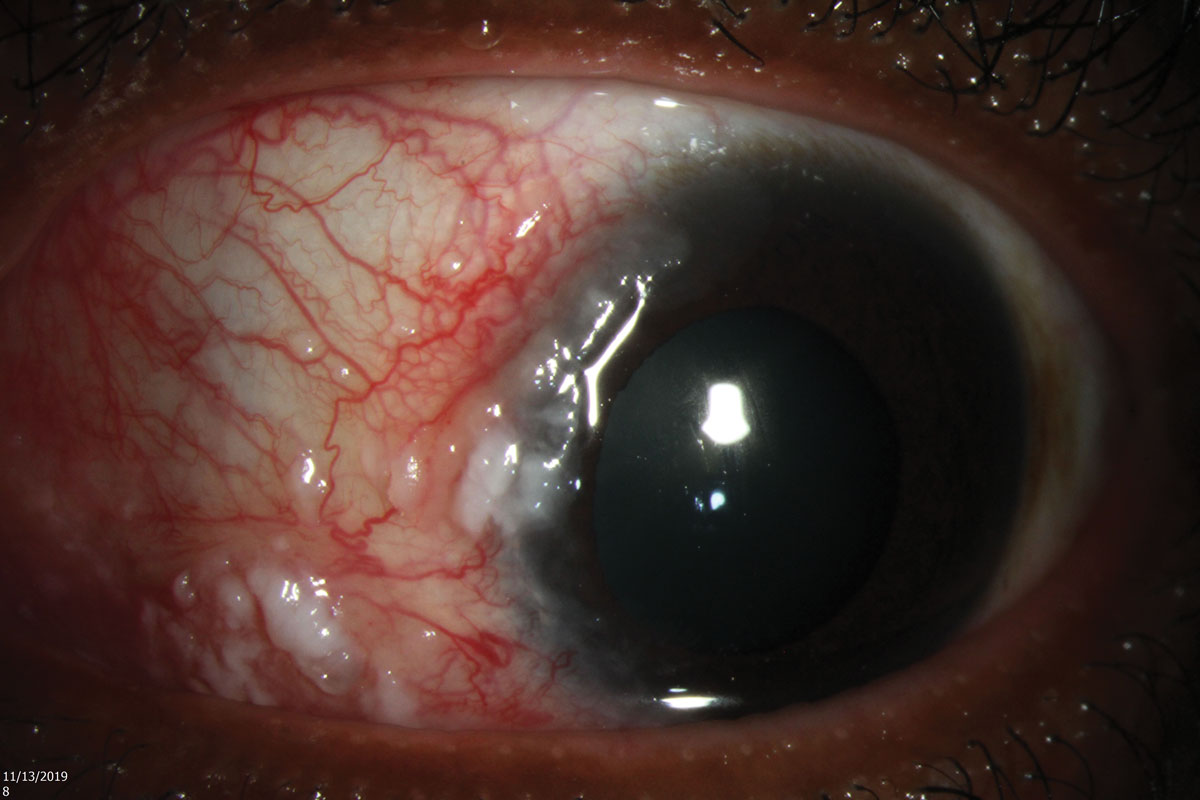 |
| Since originally surveyed in 2003, cornea specialists cited a dramatic increase in their use of primary topical monotherapy and have moved away from surgical excision alone for the treatment of ocular surface squamous neoplasia. Photo: Chris Sindt, OD. Click image to enlarge. |
Surgical excision was once the dominant method for treating ocular surface squamous neoplasia, but the realization of its downsides and introduction of alternative therapies have dropped its usage from 57% in 2003 to 16% in 2022, according to a survey published in the journal Cornea.
An umbrella term that encapsulates a mostly nonpigmented cancerous epithelial abnormality of the conjunctiva and cornea, ocular surface squamous neoplasia (OSSN) comprises a wide spectrum of histologic diagnoses, including mild epithelial dysplasia and invasive squamous carcinoma. Risk factors for OSSN are UV radiation exposure, immunosuppression and human papillomavirus infection. In the past, cornea specialists opted for surgical excision exclusively to treat OSSN, but risks of recurrence, scarring and others led the adoption of other therapies, such as 5-fluorouracil, interferon and mitomycin C. Combination therapy consisting of surgical excision followed by adjuvant medical intervention has also proved successful.
Considering all the variations on treatment, surveys of members of the Cornea Society and Ocular Microbiology and Immunology Group were conducted in 2003 and 2012 to ask their practice patterns for OSSN management. This newly released survey included 285 individuals from those organizations and aimed to shed light on the changes in these treatments over the course of two decades. The results show a dramatic increase in the reported use of primary topical monotherapy, from 58% in 2012 to 73% in 2022.
The survey also looked at the rate of favoritism of medical treatments. Overall, interferon remained the most favorable, going from 14% in 2003, 56% in 2012, and 55% in 2022. Use of 5-fluorouracil had a notable increase, from only 3% in 2012 to 23% in the present study. A significant decrease in mitomycin C was also observed, from 37% in 2012 to 19% currently. Primary medical therapy was also shown to be the preferred management for lesions <2mm, whereas 2012 respondents named tumor excision alone as the preferred treatment. Lesions between 3mm and 8mm showed an equal use of topical monotherapy or excision with topical therapy in the latest study.
As those who participated in the survey identified themselves as corneal specialists, the study authors recognized that this might be a limitation since it doesn’t represent all clinicians who treat OSSN. Additionally, interferon, which is no longer produced in the U.S., was available during the administration of this survey, therefore the authors suspect that 5-fluorouracil may become the first-line replacement for medical therapy.
“Despite these limitations, this study demonstrates a continued paradigm shift in the management of OSSN,” the authors stated. “The use of primary medical therapy as the initial approach has increased significantly, in lesions of all sizes. Similarly, there was a decrease in the utilization of surgical excision alone, without the use of postoperative medical therapy.”
Greenfield JA, Cohen AK, Galor A, Chodosh J, Stone D, Karp CL. Ocular surface squamous neoplasia: Changes in the standard of care 2003 to 2022. Cornea. January 18, 2024. [Epub ahead of print]. |

